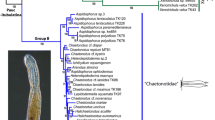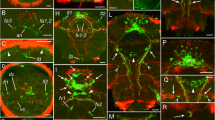Abstract
The annelid body can be subdivided into three main regions: the prostomium, the body segments, and the pygidium. The prostomium and pygidium, originating from the episphere and the posterior part of the hyposphere of a trochophore larva, are usually mentioned as non-homologous to body segments. However, recent studies revealed that the pygidium of several annelid species is far more complex than previously mentioned and possesses some segment-like features. To assess the diversity of a pygidial organization, I describe the innervation and muscular system of the pygidium in 19 annelid species belonging to the order Phyllodocida using phalloidin labeling, immunohistochemistry and confocal scanning microscopy. The musculature of the pygidium varies between families and usually consists of the circular and/or horseshoe-shaped hindgut sphincter muscles. In several families it can be accompanied by small additional transversal or dorso-ventral muscles. In contrast to the variable musculature, the pygidial innervation is far more uniform and in general comprises two huge main longitudinal nerves, a terminal commissure between them, and paired circumpigidial nerves. The pygidial epithelium bears numerous receptor cell endings, suggesting that the pygidium may act as an important sensory organ. The obtained results are in accordance with the recent data and indicate that such muscular and nervous organization may be characteristic of the whole order Phyllodocida.










Similar content being viewed by others
References
Anderson DT (1966) The comparative embryology of the Polychaeta. Acta Zool 47:1–42
Andrade SCS, Novo M, Kawauchi GY et al (2015) Articulating “Archiannelids”: phylogenomics and annelid relationships, with emphasis on Meiofaunal Taxa. Mol Biol Evol 32(11):2860–2875. https://doi.org/10.1093/molbev/msv157
Bubko OV, Minichev YS (1972) Nervous system in Oweniidae (Polychaeta). Zoologichesky Zhurnal 51:1288–1299
Filippova A, Purschke G, Tzetlin AB et al (2005) Reconstruction of the musculature of Magelona cf. mirabilis (Magelonidae) and Prionospio cirrifera (Spionidae) (Polychaeta, Annelida) by phalloidin labeling and cLSM. Zoomorphology 124:1–8. https://doi.org/10.1007/s00435-004-0106-7
Filippova A, Purschke G, Tzetlin AB, Müller MCM (2006) Three-dimensional reconstruction of the F-actin musculature of Dorvillea kastjani (Dorvilleidae: Polychaeta) by means of phalloidin-labelling and cLSM. Sci Mar 70:293–300. https://doi.org/10.3989/scimar.2006.70s3293
Filippova A, Purschke G, Tzetlin AB, Müller MCM (2010) Musculature in polychaetes: comparison of Myrianida prolifera (Syllidae) and Sphaerodoropsis sp. (Sphaerodoridae). Invertebr Biol 129:184–198. https://doi.org/10.1111/j.1744-7410.2010.00191.x
Harrison FW, Gardiner SL (1992) Microscopic anatomy of invertebrates, volume 7, Annelida. Wiley-Liss, New York
Helm C, Beckers P, Bartolomaeus T et al (2018) Convergent evolution of the ladder-like ventral nerve cord in Annelida. Front Zool 15:36
Hessling R (2002) Metameric organisation of the nervous system in developmental stages of Urechis caupo (Echiura) and its phylogenetic implications. Zoomorphology 121:221–234. https://doi.org/10.1007/s00435-002-0059-7
Hessling R (2003) Novel aspects of the nervous system of Bonellia viridis (Echiura) revealed by the combination of immunohistochemistry, confocal laser-scanning microscopy and three-dimensional reconstruction. Hydrobiologia 496:225–239. https://doi.org/10.1023/A:1026153016913
Hessling R, Westheide W (2002) Are Echiura derived from a segmented ancestor? Immunohistochemical analysis of the nervous system in developmental stages of Bonellia viridis. J Morphol 252:100–113. https://doi.org/10.1002/jmor.1093
Heuer CM, Müller CH, Todt C, Loesel R (2010) Comparative neuroanatomy suggests repeated reduction of neuroarchitectural complexity in Annelida. Front Zool 7:13. https://doi.org/10.1186/1742-9994-7-13
Horton T, Kroh A, Ahyong S et al (2018) World register of marine species (WoRMS). http://www.marinespecies.org. Accessed 27 Dec 2018
Ivanov I, Tzetlin A (1997) Fine structure of body cavity of Phyllodocidae (Annelida, Polychaeta). Morphofunctional analysis. Doklady Akademii Nauk 354:272–277
Jirkov IA (2001) Polychaeta of the Arctic Ocean. Janus-K, Moscow
Kerbl A, Bekkouche N, Sterrer W, Worsaae K (2015) Detailed reconstruction of the nervous and muscular system of Lobatocerebridae with an evaluation of its annelid affinity. BMC Evol Biol 15:277. https://doi.org/10.1186/s12862-015-0531-x
Kerbl A, Fofanova EG, Mayorova TD et al (2016) Comparison of neuromuscular development in two dinophilid species (Annelida) suggests progenetic origin of Dinophilus gyrociliatus. Front Zool 13:49. https://doi.org/10.1186/s12983-016-0181-x
Kristof A, Wollesen T, Wanninger A (2008) Segmental mode of neural patterning in sipuncula. Curr Biol 18:1129–1132. https://doi.org/10.1016/j.cub.2008.06.066
Kvist S, Siddall ME (2013) Phylogenomics of Annelida revisited: a cladistic approach using genome-wide expressed sequence tag data mining and examining the effects of missing data. Cladistics 29:435–448
Lehmacher C, Fiege D, Purschke G (2013) Immunohistochemical and ultrastructural analysis of the muscular and nervous systems in the interstitial polychaete Polygordius appendiculatus (Annelida). Zoomorphology 133:21–41. https://doi.org/10.1007/s00435-013-0203-6
Mchugh D (2000) Molecular phylogeny of the Annelida. Can J Zool 78:1873–1884. https://doi.org/10.1139/z00-141
McHugh D (2005) Molecular systematics of polychaetes (Annelida). Hydrobiologia 535/536:309–318. https://doi.org/10.1007/s10750-004-4414-1
Müller MCM, Henning L (2004) Ground plan of the polychaete brain—I. Patterns of nerve development during regeneration in Dorvillea bermudensis (Dorvilleidae). J Comp Neurol 471:49–58. https://doi.org/10.1002/cne.20022
Müller MCM, Westheide W (2002) Comparative analysis of the nervous systems in presumptive progenetic dinophilid and dorvilleid polychaetes (Annelida) by immunohistochemistry and cLSM. Acta Zool 83:33–48. https://doi.org/10.1046/j.1463-6395.2002.00096.x
Müller MCM, Worsaae K (2006) CLSM Analysis of the phalloidin-stained muscle system in Nerilla antennata, Nerillidium sp. and Trochonerilla mobilis (Polychaeta; Nerillidae). J Morphol 267:885–896. https://doi.org/10.1002/jmor
Orrhage L, Müller MCM (2005) Morphology of the nervous system of Polychaeta (Annelida). Hydrobiologia 535–536:79–111. https://doi.org/10.1007/s10750-004-4375-4
Purschke G (1997) Ultrastructure of Nuchal organs in polychaetes (Annelida)—new results and review. Acta Zool 78:123–143
Purschke G (2005) Sense organs in polychaetes (Annelida). Hydrobiologia 535/536:53–78. https://doi.org/10.1007/s10750-004-4358-5
Purschke G, Müller MCM (2006) Evolution of body wall musculature. Integr Comp Biol 46:497–507. https://doi.org/10.1093/icb/icj053
Purschke G, Bleidorn C, Struck T (2014) Systematics, evolution and phylogeny of Annelida—a morphological perspective. Mem Museum Victoria 71:247–269
Rimskaya-Korsakova NN, Kristof A, Malakhov VV, Wanninger A (2016) Neural architecture of Galathowenia oculata Zach, 1923 (Oweniidae, Annelida). Front Zool 13:5. https://doi.org/10.1186/s12983-016-0136-2
Rota E, Carchini G (1999) A new Polygordius (Annelida: Polychaeta) from Terra Nova Bay, Ross Sea, Antarctica. Polar Biol 21:201–213. https://doi.org/10.1007/s003000050354
Rouse GW, Fauchald K (1997) Cladistics and polychaetes. Zool Scr 26:139–204. https://doi.org/10.1111/j.1463-6409.1997.tb00412.x
Rouse GW, Fauchald K (1998) Recent views on the status, delineation and classification of the Annelida. Am Zool 38:953–964. https://doi.org/10.1093/icb/38.6.953
Rouse GW, Pleijel F (2003) Problems in polychaete systematics. Hydrobiologia 496:175–189. https://doi.org/10.1023/A:1026188630116
Schindelin J, Arganda-Carreras I, Frise E et al (2012) Fiji: an open-source platform for biological-image analysis. Nat Methods 9:676–682. https://doi.org/10.1038/nmeth.2019
Schlawny A, Hamann T, Müller MA, Pfannenstiel H (1991) The catecholaminergie system of an annelid (Ophryotrocha puerilis, Polychaeta). 265:175–184
Siddall ME (2006) A molecular phylogeny of annelids. Cladistics 22:1–23
Starunov VV, Lavrova OB (2013) The structure of the nervous system and muscles of the pygidium in the polychaete Alitta virens (Nereididae). Dokl Biol Sci 451:235–237. https://doi.org/10.1134/S0012496613040078
Starunov VV, Zaitseva OV (2018) Comparative study of pygidial organization in polychaetes of the families nephtyidae and syllidae. Dokl Biol Sci 478:12–15. https://doi.org/10.1134/S0012496618010039
Starunov VV, Dray N, Belikova EV et al (2015) A metameric origin for the annelid pygidium? BMC Evol Biol 15:25. https://doi.org/10.1186/s12862-015-0299-z
Storch V (1968) Zur vergleichenden Anatomie der segmentalen Muskelsysteme und zur Verwandtschaft der Polychaeten Familien. Zeitschrift für Morphologie Ökologie der Tiere 63:251–342
Struck TH, Schult N, Kusen T et al (2007) Annelid phylogeny and the status of Sipuncula and Echiura. BMC Evol Biol 7:57. https://doi.org/10.1186/1471-2148-7-57
Struck TH, Paul C, Hill N et al (2011) Phylogenomic analyses unravel annelid evolution. Nature 471:95–98. https://doi.org/10.1038/nature09864
Struck TH, Golombek A, Weigert A et al (2015) The evolution of annelids reveals two adaptive routes to the interstitial realm. Curr Biol 25:1993–1999. https://doi.org/10.1016/j.cub.2015.06.007
Tzetlin AB, Filippova AV (2005) Muscular system in polychaetes (Annelida). Hydrobiologia 535:113–126. https://doi.org/10.1007/s10750-004-1409-x
Weidhase M, Helm C, Bleidorn C (2015) Morphological investigations of posttraumatic regeneration in Timarete cf. punctata (Annelida: Cirratulidae). Zool Lett. https://doi.org/10.1186/s40851-015-0023-2
Weidhase M, Bleidorn C, Beckers P, Helm C (2016) Myoanatomy and anterior muscle regeneration of the fireworm Eurythoe cf. complanata (Annelida: Amphinomidae). J Morphol 277:306–315. https://doi.org/10.1002/jmor.20496
Weigert A, Bleidorn C (2016) Current status of annelid phylogeny. Org Divers Evol 16(2):345–362. https://doi.org/10.1007/s13127-016-0265-7
Weigert A, Helm C, Meyer M et al (2014) Illuminating the base of the annelid tree using transcriptomics. Mol Biol Evol 31:1391–1401. https://doi.org/10.1093/molbev/msu080
Zhadan A, Vortsepneva E, Tzetlin A (2014) Three-dimensional reconstruction of the musculature of Cossura pygodactylata Jones, 1956 (Annelida: Cossuridae). Zool Anz 253:181–191. https://doi.org/10.1007/s00435-015-0282-7
Acknowledgements
The author is grateful to Prof. Dr. Thomas Bartolomaeus and Dr. Andrey (A) Dobrovolsky, Dr. Elena E. Voronezhskaya and Olga (B) Lavrova for help with result interpretation and fruitful discussions. I am also grateful to Alexey Miroliubov for the help with scanning electron microscopy. The work was supported by the research grant RFBR16-34-60134 mol_a_dk and by Zoological Institute Project AAAA-A17-117030110029-3. The scientific research was performed at the Center for molecular and cell technologies, Center for Culturing Collection of Microorganisms, center “CHROMAS” of St. Petersburg State University and “Taxon” Research Resource Center of Zoological Institute RAS (http://www.ckp-rf.ru/ckp/3038/?sphrase_id=8879024).
Author information
Authors and Affiliations
Corresponding author
Ethics declarations
Ethical standards
All applicable international, national, and institutional guidelines for the care and use of animals were followed. I neither used endangered species nor were the investigated animals collected in protected areas.
Additional information
Publisher’s Note
Springer Nature remains neutral with regard to jurisdictional claims in published maps and institutional affiliations.
Electronic supplementary material
Below is the link to the electronic supplementary material.
Innervation of the pygidium in unidentified atypical Syllid (presumably Syllis fasciata) with single unpaired pygidial cirrus. 3D rotatable reconstruction (AVI 7759 KB)
Rights and permissions
About this article
Cite this article
Starunov, V.V. The organization of musculature and the nervous system in the pygidial region of phyllodocid annelids. Zoomorphology 138, 55–71 (2019). https://doi.org/10.1007/s00435-018-00430-4
Received:
Revised:
Accepted:
Published:
Issue Date:
DOI: https://doi.org/10.1007/s00435-018-00430-4




